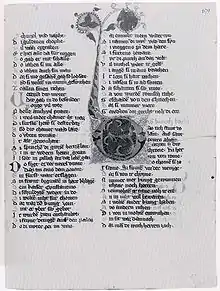
The Kaiserchronik (Imperial Chronicle) is a 12th-century chronicle written in 17,283 lines of Middle High German verse.[1][2] It runs from Julius Caesar to Conrad III, and seeks to give a complete account of the history of Roman and German emperors and kings, based on a historiographical view of the continuity of the Roman and German successions. The overall pattern is of a progression from pagan to Christian worlds, and theological disputations stand at the turning-points of the Christianization of the Empire.[3] However, much of the material is legendary and fantastic, suggesting that large sections are compiled from earlier works, mostly shorter biographies and saints' lives.[4]
The chronicle was written in Regensburg some time after 1146. The poet (or at least the final compiler) was presumably a cleric in secular service, a partisan of the Guelphs. However the view that it was written by Konrad der Pfaffe, author of the Rolandslied, has been discredited. Known sources include the Chronicon Wirzeburgense, the Chronicle of Ekkehard of Aura, and the Annolied; the relationship to the Annolied has received particular attention in scholarship, as earlier views of the priority of the Kaiserchronik, or of a shared source, were gradually dismissed.[5] Judging from the large number of surviving manuscripts (twelve complete and seventeen partial), it must have been very popular, and it was twice continued in the 13th century: the first addition, the "Bavarian continuation", comprised 800 verses, while the second, the "Swabian continuation", which brought the poem to the Interregnum (1254–73), consisted of 483 lines. The Kaiserchronik in turn was used as an important source for other verse chronicles in the thirteenth century, most notably that of Jans der Enikel.
The text of the Kaiserchronik is preserved in a total of some 50 manuscripts, of which 20 have the full text. Of these, five predate the 14th century, including one of the late 12th century (the Vorau ms.).[6] The main witnesses are:
- Vorau, Stiftsbibl., Cod. 276 (früher XI), c. 1175-1200 (Schröder ms. 1)
- Heidelberg, Universitätsbibl., Cpg 361, mid-13th c. (Schröder ms. 4)
- Prag, Nationalbibl., Cod. XXIII.G.43, c. 1225-1250 (Schröder ms. 18)
- Wien, Österr. Nationalbibl., Cod. 413, mid-13th c. (Schröder ms. 25)
- Wien, Österr. Nationalbibl., Cod. 2693, c. 1275-1300 (Schröder ms. 16)
- München, Staatsbibl., Cgm 37, c. 1325-1350 (Schröder ms. 2)
- Wolfenbüttel, Herzog August Bibl., Cod. 15.2 Aug. 2°, early 14th c. (incomplete text, Schröder ms. 3)
The chronicle was first edited in full in 1849-54 by Hans Ferdinand Massmann.[7] Massmann was in a bitter academic dispute with August Heinrich Hoffmann von Fallersleben, an "almost proprietal struggle" over the priority of the respective manuscripts they had access to. Müller (1999) categorizes Massmann's work as an editionsphilologischer Amoklauf (as it were "editorial philology gone postal"), as Massmann goes out of his way to ignore the Vorau ms., to the point of using the 1639 edition of Annolied by Martin Opitz as a "Kaiserchronik fragment" in higher standing than the Vorau ms.[8] The only critical edition besides Massmann's is that of Edward Schröder (1892).[9] There is also a classroom edition of excerpts with parallel translations in English.[10]
References
- ↑ Frank Shaw, "Kaiserchronik", Encyclopedia of the Medieval Chronicle, 2010, p. 956.
- ↑ Eberhard Nellmann, "Kaiserchronik", Lexikon des Mittelalters, vol. 5, 1991
- ↑ Graeme Dunphy, "On the Function of the Disputations in the Kaiserchronik", The Medieval Chronicle, 5 (2009), pp. 77-86.
- ↑ Friedrich Ohly, Sage und Legende in der Kaiserchronik, 1940.
- ↑ Mathias Herweg, Ludwigslied, De Heinrico, Annolied: Die deutschen Zeitdichtungen des frühen Mittelalters im Spiegel ihrer wissenschaftlichen Rezeption und Erforschung, Wiesbaden: Reichert, 2002.
- ↑ handschriftencensus.de
- ↑ Massmann, H. F. Der keiser und der kunige buoch, oder die sogenannte Kaiserchronik, Gedicht des 12. Jahrhunderts in 18578 Reimzeilen. 3 vols. (Quedlinburg, Basse, 1849–54)
- ↑ Stephan Müller, Vom Annolied zur Kaiserchronik: Zur Text- und Forschungsgeschichte einer verlorenen deutschen Reimchronik, Heidelberg: Carl Winter 1999. "Müller rightly categorizes Massmann's Kaiserchronik as an 'editionsphilologischer Amoklauf', highlighting how he cited Opitz's Annolied as a Kaiserchronik fragment and used it as such in his own apparatus. Massmann insisted on the priority of the Heidelberg manuscript over that of Vorau, largely because he had access to it, which put him personally in a position of power. Editing the Daniel passages, which are missing in the Heidelberg manuscript, he spurned the Vorau text, adopting instead the wording of Opitz with the verses rearranged into the Vorau manuscript's sequence. Müller cheekily calls early scholars like Massmann, whose work has been superseded yet whose influence lingers, the 'Untoten', the 'living dead'." Graeme Dunphy, review of Müller (1999) in Modern Language Review, 98 (2003), pp. 755-757.
- ↑ Schröder, E., ed. Die Kaiserchronik eines Regensburger Geistlichen Hanover: Hahnsche Buchhandlung; in Monumenta Germaniae historica. Deutsche Chroniken I,i (1892).
- ↑ James A. Schultz (ed./tr), Sovereignty and Salvation in the Vernacular, 1050-1150. Das Ezzolied, Das Annolied, Die Kaiserchronik vv. 247-667, Das Lob Salomons, Historia Judith. (= Medieval German Texts in Bilingual Editions vol. 1), Kalamazoo MI: Western Michigan University Press, 2000.
Further reading
- Dale, Johanna. "Imperial Self-Representation and the Manipulation of History in Twelfth-Century Germany: Cambridge, Corpus Christi College MS 373", German History, 29:4 (2011), 557–83.
- Myers, Henry A. The Book of Emperors: A Translation of the Middle High German Kaiserchronik. Morgantown: West Virginia University Press, 2013.
- Rubel, Alexander. "Caesar und Karl der Große in der Kaiserchronik. Typologische Struktur und die translatio imperii ad Francos", Antike und Abendland, 47 (2001), 146–63.